AMD Announces New, Higher Clocked Radeon HD 7950 with Boost
by Ryan Smith on August 14, 2012 11:00 AM ESTPerformance, Power, Temperature, & Noise
Because the 7950B is not strictly a new SKU, and because the performance of the 7950B isn’t very far ahead of the 7950, we’re going to keep our look at the 7950B’s performance relatively short. As always, if you want a complete breakdown of performance please see Bench, which has our complete results for the 7950B and over two dozen other cards.
Kicking things off, we wanted to start with a quick look at clockspeeds. Unfortunately AMD still hasn’t come through on their promise to expose the precise clockspeeds of their Southern Islands cards, which means we’re stuck looking at clockspeeds in a halfway blind manner. We cannot tell when PowerTune throttling has kicked in to push clockspeeds below 850MHz, and at the other end of the spectrum we cannot tell what PT Boost is doing when it’s boosting. As a result we can only see two card states, the base state of 850MHz when the 7950B is operating at or below 850MHz, and the PT Boost state of 925MHz when the 7950B is operating at between 851MHz and 925MHz. Still, this is just enough information to piece something together.
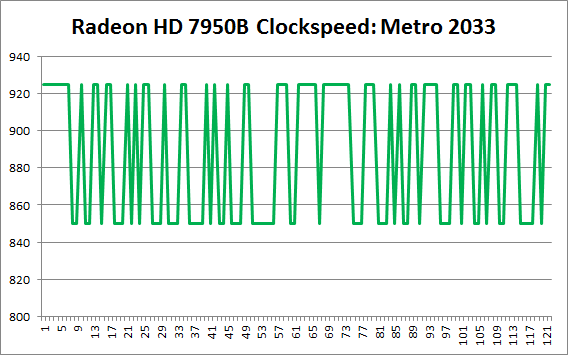
The above is a graph of clockspeeds when running Metro 2033 at 1920x1200, and it’s virtually identical to what we see with other games. The 7950B fluctuates wildly between its base state and its boost state. This is not the kind of behavior we see from the 7970GE or for that matter NVIDIA’s GTX 600 cards. This fluctuating behavior is unique to the 7950B.
So what’s going on? As near as we can tell, the power requirements for boosting are so high that the 7950B simply cannot maintain that boost for any significant period of time. Almost as soon as the 7950B boosts needs to go back to its base state in order to keep power consumption in check. The culprit here appears to be the 7950B’s very high boost voltage of 1.25v, which at 0.125v over the card’s base voltage makes the boost state very expensive from a power standpoint. If our theory is correct then this means that the 7950B never gets very far past its base clockspeed, and compared to the 7970GE, PT Boost is almost entirely wasted here.
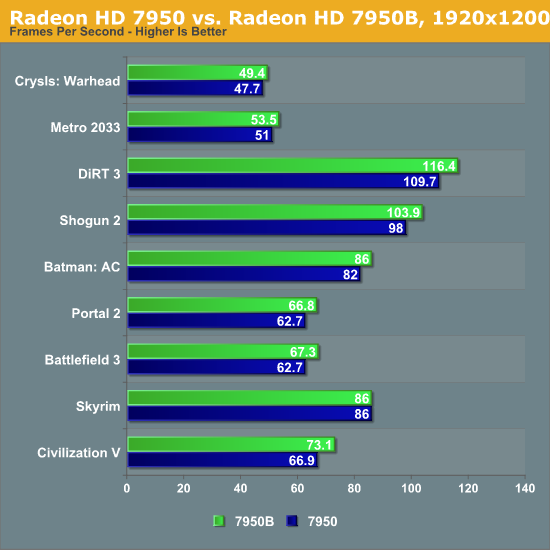
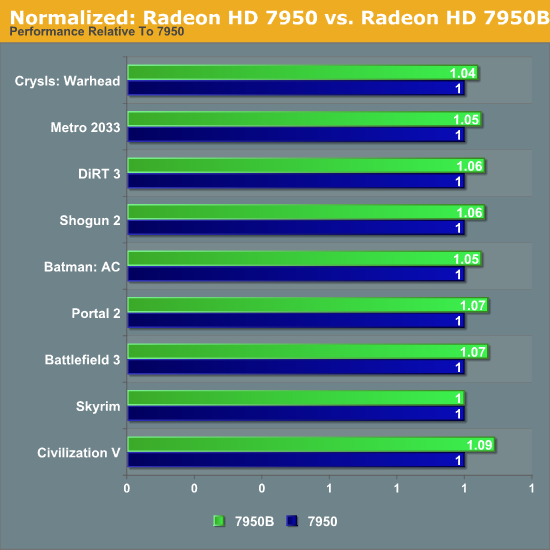
Looking at our performance charts, what we’re seeing would seem to confirm our theory. Keeping in mind that the base clockspeed of the 7950B is 6.25% higher than the 7950, the only time we see a significant jump in performance beyond that is with Civilization 5, where performance increases by 9%. Otherwise performance increases by merely 4% in Crysis, up to 7% in Battlefield 3. Not counting Skyrim (which is CPU limited), we’re looking at an average performance gain of just over 6%, which is very close to the increase in the base clockspeed relative to the 7950.
As we’ve stated before this is free performance and we’re happy to take it, but at the end of the day 6% is not nearly enough to matter with the current competition. Until such a time where the competitive landscape changes, the 7950 will continue to be well behind its next-closest competitor, GTX 670.
Power, Temperature, & Noise
Bringing things to a close, we quickly wanted to break out power, temperature, and noise. As we’ve stated earlier, AMD is making a clear set of tradeoffs with the 7970GE and 7950B, forgoing power efficiency in the name of performance. We’ve seen the 6% performance boost the 7950B offers, but what exactly has the cost been?
| Radeon HD 7950 Series Voltages | ||||
| Ref 7970B Base Voltage | Ref 7950B Boost Voltage | Ref 7950 Base Voltage | ||
| 1.125v | 1.25v | 1.093v | ||

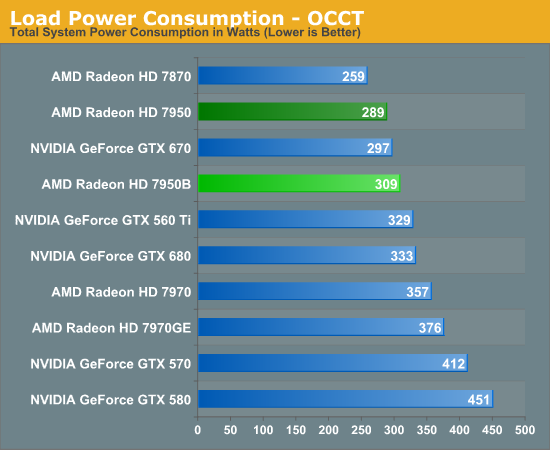
Starting as always with load power, we see that relative to the 7950, the 7950B’s power consumption at the wall is 20W higher in both tests. This fits well with AMD’s official specs, which have the TDP of the 7950B at 225W, versus 200W for the 7950. As a result of this power increase the 7950B draws more power than even the GTX 680 when it comes to Metro, though thanks to AMD’s more rigorous throttling their power consumption still comes in below the GTX 680 under OCCT.
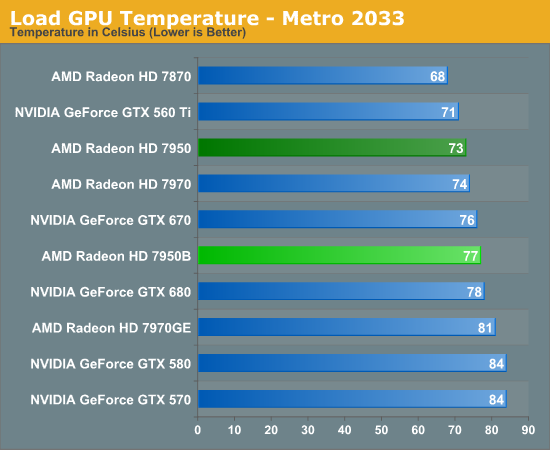
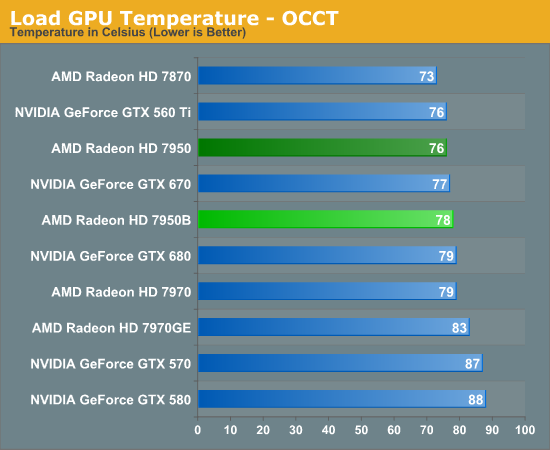
Moving on to load temperatures, it comes as no great surprise that with an increase in power consumption comes an increase in load temperatures. The 7950B still fares well here, staying below 80C in both tests, but the 4C jump in Metro is a bit more than we would have expected for only a 20W increase in power consumption.
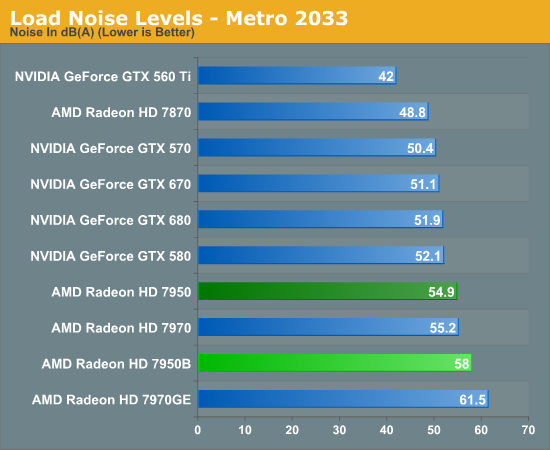

Last but not least we have our look at noise under load. Unfortunately the 7950B looks especially bad here, thanks to the more aggressive fan curve we typically see on 7950 cards. With both Metro and OCCT the 7950B is pushing 58dbA+, which is louder than even the better performing 7970. In fact all things considered this is quite a ridiculous amount of noise, the same problem the 7970GE had.
The good news is that the reference 7950 is rarely sold these days, but we have every reason to believe that aftermarket cards will see a similar jump in noise. There’s no getting around the fact that 225W is a lot of heat to dissipate, especially for designs that weren’t necessarily optimized around that level.
Wrapping things up, it’s difficult to hold a favorable opinion of the 7950B given what we’ve seen so far. AMD may be putting all of their focus into performance-per-dollar, but that doesn’t mean that performance-per-watt has suddenly stopped mattering. The 7950B’s performance boost is free from a price perspective, but the tradeoff that comes with it is anything but. A 6% jump performance for a 10% increase in power consumption and notable rise in load noise will certainly be acceptable to some users, but it’s difficult to argue that this is a good tradeoff overall.










58 Comments
View All Comments
bennyg - Wednesday, August 15, 2012 - link
Agree that 7950 is better price/perf than 670. But;Reviewers can only review what they have in their rigs. If Nvidia came out with an auto-OC feature and AMD didn't... tough for AMD but hardly "unfair advantage", remember most buyers don't OC, and everyone who bought a 670 has enjoyed their boosted clocks and frames.
And before you go alleging NV is defrauding reviewers... "surely" you need some kind of evidence that shows retail cards are measurably slower than review cards (which remember are tested in stupidly-beefy-everything-else so the GPU is as unlimited by the rest of the system as possible). Surely everyone reviewing an Intel CPU and getting higher numbers than AMD isn't in Intel's pockets too... maybe the Geforce just "wins" the last 5 months? After AMD sold heaps of well marked up cards for the first 3 months of this year, remember.
Things like this happening make me glad Apple didn't "invent" and patent the turboboost algorithm </lolapplebashing>
prdola0 - Wednesday, August 15, 2012 - link
Oh come on. Isn't it AMD who is trying desperately to hinder Nvidia's launch with an update which gives only 5% on average, yet it increases consumption by 20W and noise considerably too, and voids warranty if applied to older cards?Looking at Steam Survey, it is clear why AMD is so desperate. GTX680 has 0.90% share, while even the 7850 lineup has less, just 0.62%. If you look at the GTX670, it has 0.99%. The HD7970 has only 0.54%, about half of what GTX680 has, which is funny considering that the GTX680 is selling only half the time compared to HD7970. It means that GTX680 is selling 4 times faster.
You can see that even with the absence of Nvidia's mainstream until tomorrow, Nvidia is outselling AMD massively. And that's why AMD is trying dirty tricks, like promoting 7970Ghz and then not really selling it afterwards, the same with 7750 and now this little bump to 7950, which we might not see in reality as well. Who's to guarantee, that the cards are really comming with AMD's current track record in mind? Noone is. And the poor fella deciding to buy a 7950 would have to be informed well enough not to buy an old 7950 with the old spect and actually be able to tell them apart in a store. Most won't be able to and they won't be getting what they see in the reviews, even though this cheat is just 5%.
Peace.
jabber - Wednesday, August 15, 2012 - link
AMD/Nvidia are never too worried about total sales of their top of the range cards.It's the models below that in the $250-$75 range that pays the wages.
These cards are the equivalent of the S Class Mercedes. Basically what you find in a S Class today filters down into what we drive in ten years time.
Tech testers basically. Stuff thats in these cards will be then added into my 8770/9770 in due course.
Six years ago who would have thought $30 GPUS would have 1GB of ram on them.
prdola0 - Wednesday, August 15, 2012 - link
Well then if Nvidia sells more S-class Mercedes than AMD sells mainstream cars, you could say that AMD is in trouble. No?jabber - Wednesday, August 15, 2012 - link
So you are saying that Nvidia is selling far more $350 cards than AMD is selling $50-$250 ones?Well that would be amazing. Tech news of the century.
Fact is I've never seen one of these top of the range cards in a PC that I know of AMD or Nvidia while they are being sold.
I sometimes see them a few years after when they have filtered down via Ebay.
They sell in very small numbers compared to the rest of the ranges.
RussianSensation - Wednesday, August 15, 2012 - link
That's non-sense. Only 4-5% of cards above $350 comprise the entire sales of a GPU maker. Already shown 100x. Using Steam Hardware survey to compare sales is not accurate. NV didn't even say that Kepler on the desktop gained market share in the latest earnings. They attributed most of their success to Tegra 3 and mobile Kepler contracts.CeriseCogburn - Saturday, August 25, 2012 - link
Still, the Steam Harware Survey shows your little stupid amd pet getting it's blankity kicked.LOL
Why so sad ?
RussianSensation - Wednesday, August 15, 2012 - link
HD7970 was 1 month behind but plenty of versions are for sale on Newegg and actually even better than AMD promised:- Prices well under $499
- You still get 3 free games included, which wasn't part of the GE cards
http://www.newegg.com/Product/ProductList.aspx?Sub...
So essentially that's a faster card than all 680s except for GTX680 Lightning and it costs $30-50 less than the cheapest 680. What's not to like?
Just because people are buying 4x as many 680s doesn't mean anything. They could be stuck reading reviews from March and haven't seen 7970 GE recapture the performance crown overall and surpass 680 in Dirt 3, SKYRIM, Batman AC, especially with 8AA.
CeriseCogburn - Saturday, August 25, 2012 - link
No one is listening - Steam Survey has proven it - nleat all you want, heck you're still bleating... amd sales SUCK for the card you are promoting....Here let me help you amd fanboy out of his mind on failing sales...
The 660Ti is kicking because it STOMPS the 7870/7850 and barely costs more than 7870 and it matches and beats 7950 plenty of the time and as thejian has shown you in 660Ti thread 24/7/365 for 1920x1200 and ever more 1920x1080, and the 660Ti costs LESS than the 7950...
nVidia hit the SWEET SPOT - jamming it right in and amd is going down in sales ever more - next Steam Survey.. you'll be WEEPING and cursing the fools for not taking your twisted advice...
Happy gaming ! :-)
CeriseCogburn - Saturday, August 25, 2012 - link
LOL - " and thats why they did it. Nvidia's cards are auto overclocking, so they were gaining an unfair advantage in "stock" reviews. No more.Nvidia started all this with their boost,... "
ROFL - HAHHAHAHAAH BWAHAHAHAHAAAA
Why so sourpuss bill4, amd fanboy much ?
Look, amd blew it badly on this card - it's a hot core housefire mess.
My advice for the amd fan - go buy the average/regular 7950 and cross your fingers.
Of course my real advice is quit being such and idiot and buy the 660Ti at this point.
I mean that's a no brainer.